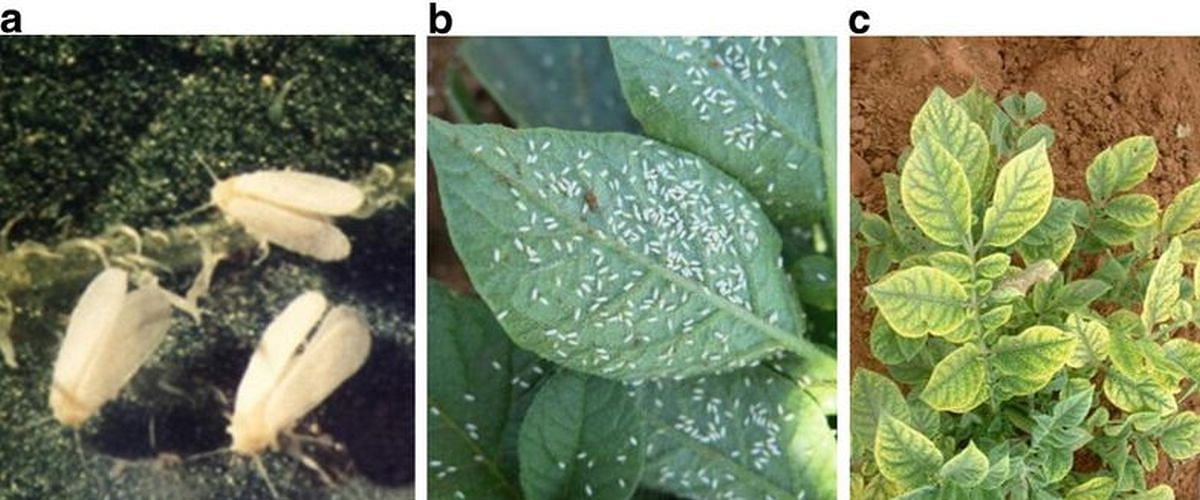Scientific description of the Whiteflies (2020)
Based on J. Kroschel. et al. (2020) Insect Pests Affecting Potatoes in Tropical, Subtropical, and Temperate Regions. In: Campos H., Ortiz O. (eds) The Potato Crop. Springer, Cham
The authors of this content are Jürgen Kroschel, Norma Mujica, Joshua Okonya, Andrei Alyokhin
Bemisia tabaci (Gennadius 1989),
Trialeurodes vaporariorum (Westwood 1856) (Homoptera: Aleyrodidae)
Distribution
Bemisia tabaci is a common pest in tropical and subtropical regions but is less prominent in temperate habitats (image below). Trialeurodes vaporariorum originated in tropical or subtropical America (probably Brazil or Mexico). Currently, it has become a cosmopolitan pest, with records in every zoogeographic region of the world (CABI 2017e, f).

Bemisia tabaci adults on potato leaves (a, b) and potato plant with symptoms of Potato yellow vein virus (PYVV) transmitted by Trialeurodes vaporariorum (c). (Courtesy: CIP)
Host range
B. tabaci is a highly polypaghous pest. In addition to Solanaceae crops such as potato, tomato, and eggplant, it infests a wide range of other field crops and vegetables; among those are sweetpotato (Ipomoea batatas (L.) Lam.), cotton, beans, cucumber, melon, soybean, cassava (Manihot esculenta Crantz), and many others.
Symptoms of infestation
Adult whiteflies can be easily seen on the underside of the leaves. Sucking sap from plant tissue is associated with several physiological plant disorders, such as chlorosis of new foliage. Heavy infestations with hundreds of adult greenhouse whiteflies on the lower surfaces of potato plant leaflets produce whitish spots that subsequently turn dark.
As the population increases, sooty mold accumulates on the leaf surface, necrosis develops on the leaf margins, and some leaves curl upward. Necrotic leaf areas expand and coalesce, causing the whole leaf to dry-out. Producing sugar-rich honeydew promotes growth of sooty mold fungi, thus interfering with normal photosynthetic processes.
Adult whiteflies transmit a number of viruses, each of which has its own suite of symptoms. For example, potato apical leaf curl virus (PALCV) causes upward or downward curling of leaves.
Infection with potato yellow vein virus (PYVV) initially results in bright yellow veins. As disease progresses, the leaves become yellow, while the veins regain their green color. Infected plants may produce deformed tubers with abnormally large protruding eyes (CABI 2017e, f; Larrain et al. 2003; Sanchez and Vergara 2002).
Impacts on production losses
Both direct and indirect damage may result in yield reduction of 40% or more (Anderson et al. 2005; CABI 2017e, f; Franco-Lara et al. 2013).
Methods of prevention and control
- Monitoring pest populations.
Direct observation and use of yellow sticky traps are useful methods for monitoring whiteflies and for early detection and the documentation of relative whitefly abundance over time. - Biological control.
Despite abundant research on natural enemies and nonchemical control of B. tabaci few natural enemies have been identified and used in biological control. Nymphs are affected by entomopathogenic fungi such as Verticillium lecanii Zimmerman, Paecilomyces farinosus Holmsk, and P. fomosoroseus Wize. V. lecanii has been developed as a biopesticide (CABI 2017e, f). - Crop management.
Maize can be planted as barrier and/or cucurbits as trap crop for controlling adults and to enhance the development of biological control agents (CABI 2017e, f). - Physical control.
Yellow attracts whitefly adults. Stationary yellow stick traps are recommended to be installed at planting around fields to capture whitefly adults migrating from other crops. The use of mobile and stationary yellow sticky traps can effectively reduce white fly adult populations in potato (Cisneros and Mujica 1999c; Mujica 1998). - Chemical Control.
Avoid use of broad spectrum insecticides in order not to affect natural enemies. The chitin inhibitor, buprofezin, has shown high efficacy (>90%) in controlling immature stages. Soaps (such as potassium soaps) can also be applied on a small scale. Chemical control should be based on using an action threshold of three nymphs per leaf (CABI 2017e, f; Cisneros and Mujica 1999c).
